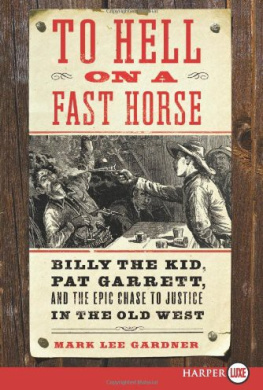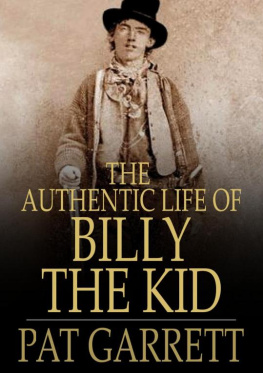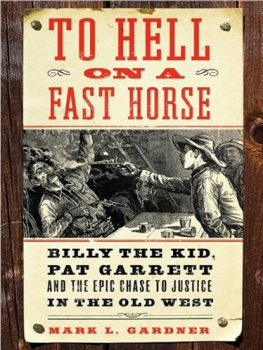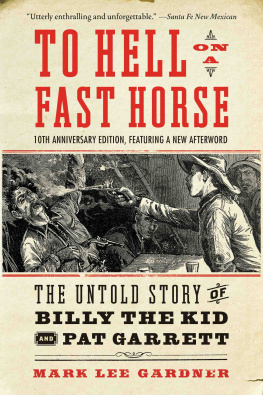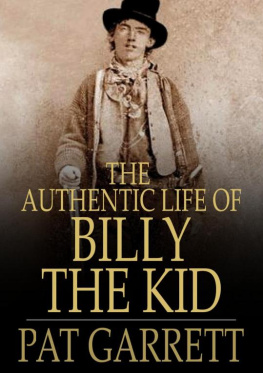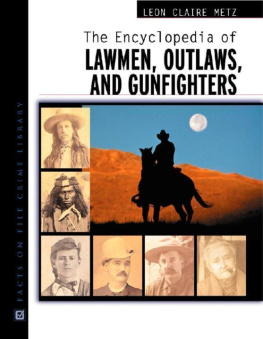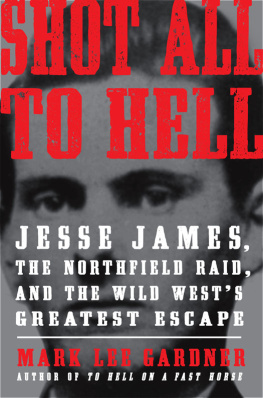For my daughter and son,
Christiana and Vance
Some men find an unaccountable fascination in the danger and outlawry of the frontier far beyond my understanding.
SUSAN E. WALLACE ,
wife of Governor Lew Wallace,
New Mexico Territory
I dont think history possibly can be true.
ORSON WELLES
Y OU CAN FEEL THE ghosts as you speed down the long, lonely roads of eastern New Mexico. The land is little changed, except for endless strands of wire fence and an occasional traffic sign. Out in the distance, they are there: Billy the Kid and the Regulators, Charlie Bowdre, Tom Folliard, and Pat Garrett. The days may be gone when blood flowed freely along the Pecos and Rio Bonito, but the music of the fandango, and Billys dancing, and the lovers kissesall difficult to conjureare all still there. They are in the wind, the moonlight, in the cacophony of coyotes, and in the silence before the first rays of sunlight spill over the horizon.
And there are the stories, because New Mexico is full of stories. It is through these stories that the ghosts come to haunt us. In the stories, we think we see them, understand them, even somehow know them. But they are still ghosts, and they can conceal the truth like a pirate hides his plunder.
Billy the Kid and Pat Garrett were perhaps the greatest of our Old West legends. By building on the output of previous scholars, and conducting extensive original research in archival and private collections from Texas to Arizona to Utah to Colorado, I have made the ghosts give up a few more of their secrets.
All of the dialogue in quotes on the following pages came from primary sources: contemporary newspapers, letters, oral histories, autobiographies, and the like. Nothing has been made up. Granted, some recollections were written or dictated decades after the fact, and one can legitimately question how accurately someone might remember what somebody else said forty years previous, but even so they are the recollections of eyewitnesses. And in some cases, they are all we have.
I personally explored most of the places that figure in this story: Las Vegas, Anton Chico, Fort Sumner, Puerto de Luna, Roswell, Lincoln, White Sands, White Oaks, Alameda Arroyo, Mesilla, Silver City, and on and on. In some places, crowded Santa Fe, for example, the ghosts had been obliterated by asphalt, noise, and phony adobe facades. In others, such as the stairway of the old Lincoln courthouse, Billy, Pat, Bob Olinger, and James Bell seemed to walk side by side up its creaking wooden steps.
Many of the people connected with this story did not deserve their fate, Billy and Garrett most of all. They were like lovers, in a waydoomed, said Rudolph Wurlitzer, the screenwriter for Sam Peckinpahs classic film, Pat Garrett and Billy the Kid . They lived in a harsh land and time, a time that saw tremendous change while still retaining, in some instances, the cutthroat ways of its recent past. In the end, it was not as much about right versus wrong, lawman versus outlaw as it was about survival. For others to survive, Billy could not, Garrett could not.
These two men perished long ago, and that is the cold truth of history, but their ghosts are still there. Billy forever calls out to us from the darkness of the past: Quin es? Who is it? And like Garrett, sitting, waiting, we are unable to answer, unable to stop what happens next.
Facing Justice
Come and take him!
PAT F. GARRETT
I T WAS THE DAY after Christmas, 1880, at approximately 4:00 P.M ., when a mule-drawn wagon accompanied by five armed horsemen rapidly approached the outskirts of Las Vegas in the Territory of New Mexico. The leader of the men on horseback rode stoop shouldered, a natural consequence of his six-foot-four-inch frame. He was as thin as a rail, and even as bundled up as he was, he seemed to be all arms and legs. He had a dark mustache, light gray eyes, and a swarthy face that showed the years he had spent on the open range of Texas and New Mexico.
Seated in the wagon were four dirty, trail-worn men in handcuffs and shackles. They were the lanky mans prisoners, and one of them was hardly out of his teens. As the wagon bounced along, the young outlaw, his blue eyes dancing about, broke into an occasional smile or burst out in a hearty laugh, exposing two buckteeth, a feature that was unattractive in most people, but for this young man seemed to add to his charm. The boyish prisoner and the tall lawman, although complete opposites, shared a common destiny. Billy the Kid and Pat Garrett had no way of knowing it, but they were fated to be forever linked in both life and death.
The Las Vegas that spread out before them was really two towns, one old and the other new. The old town had been established on the Santa Fe Trail in 1835 along the Gallinas River (what easterners would call a creek). The settlement got its name from the rivers broad grassy valley: las vegas the meadows. The new town sprang up forty-four years later when the Atchison, Topeka & Santa Fe Railroad came through a mile away on the east side of the Gallinas. In 1880, Las Vegas, the county seat of San Miguel County, numbered six thousand people, mostly Hispanos. The citys numerous hell-raisers, mostly Anglos, resided in New Town, where saloons, dance halls, and gambling establishments ran day and night.
The Las Vegas Daily Optic reported: Yesterday afternoon the town was thrown into a fever of excitement by an announcement that the Kid and other members of his gang of outlaws had been captured, and were nearing the city. Sheriff Garretts party had come up the old Santa Fe Trail. Their route to the stone jailhouse on Valencia Street took them across one end of Old Towns plaza, where most people got their first glimpse of the prisoners.
Billy beamed at the crowd and spotted Dr. John H. Sutfin, owner of the Grand View Hotel. Hello, Doc! he called out. Thought I jes drop in an see how you fellers in Vegas air behavin yerselves.
The throng of gawkers, growing by the minute, followed the wagon down the muddy street to the jail, where the prisoners and guards promptly disappeared inside. A reporter for the Las Vegas Gazette cornered the thirty-year-old Garrett for a few minutes, hoping he could get the thrilling narrative of the gangs capture. Garrett almost immediately passed off the excited journalist to a posse member named Manuel Brazil, saying Brazil knew all the particulars.
Monday mornings frigid air did not stop the curious townspeople from gathering around the jail, hoping to glimpse the desperadoes: Billy the Kid, Billy Wilson, Dave Rudabaugh, and Tom Pickett, the latter being a former Las Vegas policeman. Nearly everyone knew something about Billyeven if it was only that the twenty-one-year-old had sent far too many men to their graves. His most infamous crime was the killing of Sheriff William Brady and his deputy, George Hindman, in an ambush in Lincoln during the Lincoln County War. The Kid was not the only one who fired on the sheriff and his deputies that day, but he had walked away with a murder indictment. And this murder charge was the one he feared most. In the spring of 1879, Governor Lew Wallace met with Billy in order to draw out his eyewitness testimony in another highly charged Lincoln County murder case. In exchange for this testimony, Billy was to be offered a pardon. The Kid did his part, but the pardon never came. Now Billy knew it was only a matter of time before he would face a hangmans noose.
Michael Cosgrove, the Las Vegas mail contractor, pushed through the crowd carrying four bundles under his arms. They contained new suits of clothes for the prisoners, and the Irish-born Cosgrove remarked that he wanted to see the boys go away in style. The towns two competing newspapers, the Gazette and the Optic, both managed to get reporters into Sheriff Desiderio Romeros jail that morning, but the Gazette s man got the best story. The reporter watched as a blacksmith took his hammer and cold chisel and began carefully shearing the rivets of the shackles and bracelets worn by the Kid and Billy Wilson, who were chained together. The irons had to come off before the prisoners could change their clothing. Wilson was glum and quiet, but the Kid was acting light and chippervery communicative, laughing, joking and chatting with the bystanders.

